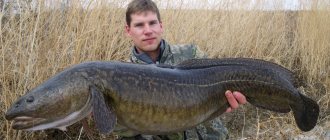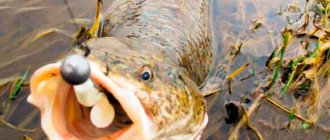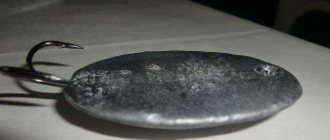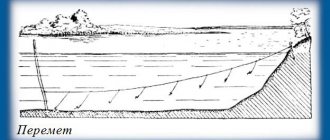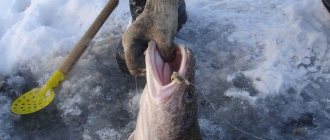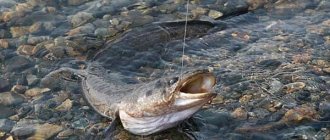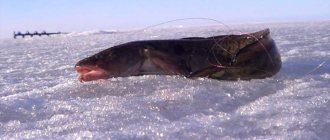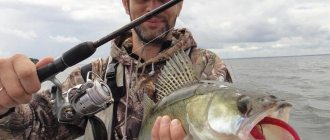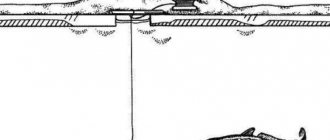Fishing for burbot in the fall is the most productive time for catching this mysterious and, to some extent, exotic fish for most of our fishermen. But the non-standard behavior of this representative of the cod fish species has made burbot hunting the least popular type of predator prey in freshwater bodies, which is not entirely justified from the point of view of the availability and simplicity of the technology for catching it.
After all, catching burbot in the fall if the angler has knowledge about its habits and habitat is not such a difficult task, but at the same time this process is both entertaining and quite interesting in terms of developing fishing strategies. We will discuss how to properly catch burbot in late autumn in the material presented to the reader below.
When does the burbot start to bite in the fall?
This predator is a cold-loving fish species and its active behavior with intensive feeding begins when the water temperature drops below 10–12 degrees. Burbot fishing in the fall begins with a drop in average daily air temperatures to around 5–8 degrees. With this fall, the water bodies quickly cool, activating the predator preparing for spawning. At the end of October, the fish begins a gradual increase in fat, which will last until spawning, towards the end of December. In contrast to the warm period of the year, in the fall burbot begins to bite steadily in the waters of the entire reservoir, without focusing on cold springs and fast tributaries of rivers. This active autumn behavior of burbot makes it less cautious, which allows it to be caught using a variety of gear, from bottom to float rigs. Fishing for burbot in late autumn is rightfully considered the golden season of burbot.
Fishing for burbot in the autumn season
Burbot belongs to the cod fish family and lives in fresh water. It is most active at water temperatures no higher than +10°C. Therefore, fishing begins in mid-autumn, in inclement weather, when the air temperature is no more than +5°C.
This fish feeds on small fish, frogs and mollusks.
The predator is found in the calm, cold waters of rivers in northern Russia, the Urals, and Siberia. Many professional fishermen go fishing to Bashkiria, where the 2021 fishing season is already open.
Finding a fishing spot
Places to catch large burbot in the fall should be looked for in small rivers where the water is clean and fast. It is found in areas that have the following features:
- the presence of a natural rocky bottom;
- estuaries or shallow waters;
- fallen trees, remaining snags covered with water;
- change from a stormy flow to a calm flow;
- islands of stone spits.
Finding a fishing spot
Burbots lead a bottom-dwelling lifestyle, spending most of it in a certain small area of the reservoir.
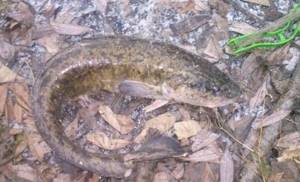
Important! The fish loves pebble and rocky bottoms with different depth levels, ranging from 1 to 15 meters. Its habitat requires clean and flowing waters.
Consequently, large rivers are one of the most promising habitats for this cod population. Small fish stay in small groups in the coastal zone, moving in search of food along the same route over a long period of time. In connection with this feature of the behavior of the predator, it is important for the fisherman to find the so-called burbot trail , which will become the prey trajectory for installing gear. Large specimens, individuals over 1.5-2 kg, lead a solitary lifestyle, taking up snags near a rapid whirlpool or an underwater cold spring for shelter. The predator is strictly nocturnal, which must be taken into account when choosing a fishing strategy even after finding a promising place.
What to use to catch burbot in the fall
The main food of freshwater cod is small fish, hiding in the rocky terrain of the reservoir. When choosing bait, the fisherman needs to focus only on the animal component of the bait and preferably with a distinct odor, and the ability to release blood or meat juice only favors a good bite. Continuing the article, we will consider the main types of burbot baits that work effectively throughout the entire autumn fishing season for this fish.
Zywiec

The favorite delicacy of burbots is ruff. Despite its spiny fins, the predator most often attacks this bait among live bait fish. Good fishing results are achieved by installing minnows and bleaks. Recently, with the spread of gobies in rivers, this type of bottom fish has also become part of the predator’s diet and is successfully used by burbots at their bets. Roach and small crucian carp are also suitable for catching this fish, but with less success compared to previous options.
Important! Before installing live bait, some fishermen press down the fish until blood and meat juice begin to flow from it.
This technique helps to attract the caught fish to the fishing point with great success. For a predator, the intense movements of the prey are not as important as the specific smell of food. Most often, live bait is placed on a hook under the upper fin.
Dung or earthworms
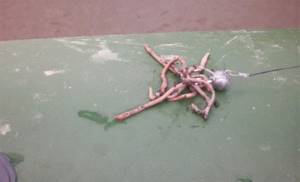
Dung scented worms are one of the most promising baits for burbot in the autumn season. Earthworms are no less suitable for fishing, but have a less concentrated odor. Predators also respond well to water worms, but due to the delicate nature of the bait, its rigs cannot always be securely attached to the hooks, especially when fishing on currents. Selected worms are used for burbot hunting, choosing large and playful individuals.
Important! To rig a worm, use hooks with long shanks, setting the bait in a bunch of five or seven specimens, piercing the worm in the middle of the length of its body.
Pieces of fish meat
The fillet of almost all types of fish, including sea fish, is suitable for bait.
Important! The cut loin part, together with the skin, but without scales, is cut into strips up to 10 cm long and 1–2 cm thick.
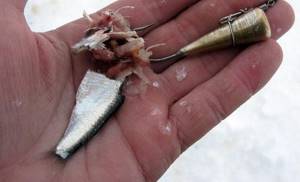
After the desired strips are formed, the meat is placed in a glass jar for half a day and left at room temperature, allowing the product to release its juice. For installations, use one strip, placing it on the hook with a through puncture in the central part.
Frog
Burbot also bites on frogs, which are caught directly in the predator’s habitat. The bait is suitable for small and medium-sized individuals with clean, bump-free skin. It is worth distinguishing and not confusing a frog with a toad.
Important! Before installation, the amphibian is pressed down, drawing blood and immobilizing the bait.
The frog is hooked onto the thigh, pierced right through with a hook with a long shank.
Other attachments
https://youtu.be/mAlNrww8Hek
Other, but promising, baits include chicken offal, including in this concept the intestines and liver of the animal, cleared of contents. Good results are obtained by fishing with beef liver, previously soaked in the animal’s blood. With the presence of mollusks such as toothless or pearl barley in the reservoir, the meat of this local inhabitant can be successfully used as bait. A long black leech that needs to be crushed before installing the rig is also suitable for fishing.
Coil
It is advisable not to save money and equip the form with a non-inertia version with a baitrunner. This type of reel will allow you to easily remove not only burbot, but also large catfish, while preserving your tackle.
fishing line
Fishing for burbot in late autumn is carried out using coarse tackle; this is not a hindrance for him. Thick versions of monks are used as a base; 0.4-0.6 mm is ideal. If the choice fell on the cord, then its optimal thickness is 0.3-0.34; there is no need to install a rope.
It is recommended to use thinner options as a leash; a monk is enough to be about 3 mm thick, and the cord is 0.20 mm thick.
When choosing a cord as the basis for collecting any fishing tackle, pay attention to its shape. It is better to give preference to round options; they will not produce loops when casting, and if one does form, it will be easier to untangle.
Sinkers
It is worth understanding that catching burbot on the Volga will require one weight of sinkers, and catching burbot on the Kama will require a completely different weight. It is based on the selected reservoir and the depths at which fishing is planned that the load is selected. The following are general recommendations:
- for blind equipment, choose a load with a swivel, but for sliding equipment this is not suitable;
- The weight of the sinker should not be less than 40 g, but the maximum weight is set by the rod used.
An important criterion is that the load lies perfectly on the bottom and is not carried away by the current. On rivers, sliding versions of a flat shape are used more often, sometimes with lugs.
Hooks
Catching burbot on a donk mostly involves the use of large single hooks. Do not be afraid of large sizes; even a small fish has a large mouth, which allows it to swallow large baits along with the appropriate hook.
Fishing in the fall on a feeder is carried out with hooks of numbers 8-12 according to the domestic classification.
Doubles are also used, but their use is not always justified.
Accessories
An important point in assembling the tackle will be the use of high-quality small parts to connect all parts of the tackle. Swivels, clasps, and winding rings are chosen only of excellent quality and from a trusted manufacturer. You shouldn’t skimp on these little things; sometimes it’s a high-quality swivel that will allow you to catch a large specimen of burbot or catfish while fishing.
When choosing accessories, you should not dwell on small options; burbot is not afraid of rough tackle; when hungry, it grabs everything in its path without fear.

Bait for autumn burbot
To lure the predator to the fishing site, burrowers have developed a technique for preparing special bait. Bait for burbot does not include plant components and is prepared from finely chopped fish meat or the liver of any animal. The chopped product is left for 10–12 hours at room temperature until juice begins to form and is subsequently mixed with sifted earthen soil. From the resulting mix, balls are prepared already on the reservoir, which are compressed, having previously been moistened to a certain consistency, depending on the strength of the current of the reservoir.
Important! The abandoned ball should reach the bottom and then fall apart into its components, forming a feeding spot.
A useful element of bait would be live maggots, added to the mixture just before the formation of the balls.
How to catch burbot in autumn
Having decided on a promising place, the fishing itself is planned at night. The fish begins searching for prey in complete darkness. At dusk and on clear moonlit nights, the fish are inactive.
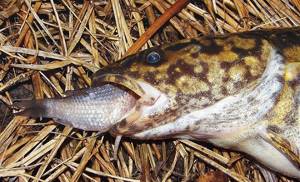
Important! Predators are most active during periods of unstable weather. Strong winds, rain and sudden changes in pressure stimulate the feeding activity of burbots.
Burbots feed from the bottom, therefore, baits are placed on the bottom base or at a distance of no more than 5 cm from it. No fires are lit on the banks in the immediate fishing areas; this stimulates the fish to escape. They try to make as little noise as possible and move along the shore only when necessary . The burbot bite looks like a single jerk followed by the alarm going off. If after ten minutes there are no repeated pulls, then you should check the bait and most likely there will be a positive result. No hooking is required; predators, having taken the bait, hide and can spend a long time without moving in one place. As a rule, the best fishing strategy is to check the gear hourly, regardless of the presence of bites.
Important! Any bite ends with a deep swallow of the bait, so it is necessary to have an extractor and pre-prepared spare leashes.
Tackle for burbot in autumn
Pre-winter activity of the predator provides fishing opportunities with various types of bottom gear. Starting from the classic version of the elastic donkey and ending with equipping spinning and feeder rods with bottom mounts, burrowers conduct successful and productive hunts. The equipment is not particularly thin and delicate, since the burbot swallows the bait on the fly without tasting it, and the basis for biting is only the competent and accurate placement of the bait on the fish trail. Making tackle for catching burbot with your own hands is quite simple and inexpensive. Let's talk in more detail about some popular and simple fishing methods.
Fishing methods
Catching burbot on the Volga will differ from catching it in smaller bodies of water. However, for any body of water you need high-quality equipment.
There are several methods for catching burbot in the fall on a large or medium-sized river, each of which involves the use of animal bait. Most often, representatives of cod fish:
- on the donk;
- to the feeder
You can try a spinning rod or float tackle, but given the active nocturnal activity and some features of swallowing bait, it will be difficult to catch using these methods.
Donka can be collected with or without a rod. An excellent version of the throw came to us from our grandfathers; all the tackle was collected on a round reel, which is called a self-reel. It is installed on the shore after casting and secured with a stick. The hook stays in this state all night; in the morning the fisherman checks what he hooked.
Catching a predator at night
Often in inclement weather and definitely in the dark, catching burbot on the river requires careful preparation, which can ensure both success and comfort of fishing.
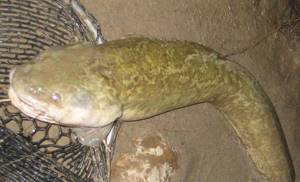
The fisherman needs to take care of having a convenient place to wait for bites, equipping a tent with shelter from rain and wind during daylight hours. The installation sites for gear are cleared of branches, bushes and tall grass. After all, casting rigs at night requires special care and caution, and unnecessary interference certainly does not help this matter. Having warm clothes, a raincoat and a thermos with hot coffee will help pass the minutes of waiting between bites. Necessary equipment when burbot fishing is the presence of a reliable electric flashlight, which will help both when casting and when fishing for the caught trophy. Before leaving, do not forget to check the batteries for their functionality, and it is best to have a spare set of suitable elements.
Important! As a rule, fish activity manifests itself from the evening, from the moment of complete darkening, until two o’clock in the morning. The next surge in exits occurs between five and seven o'clock in the morning.
The best time is autumn and spring for catching burbot on the Kama
With the arrival of the first autumn cold weather, fish such as burbot begin to dominate large bodies of water. Autumn is the best time for this predator to fatten up before the long winter. He will hunt small fish, crayfish and worms.
Experienced fishermen take advantage of the autumn feeding of burbot and actively catch it. Knowing little secrets, they catch especially large specimens.
Fish behavior
Burbot prefers chilly weather . It increases its activity with the arrival of the first autumn days. And the lower the air temperature, the higher his appetite.
The peak activity of this fish occurs in mid-October. At this time, she prefers to hunt small fish, mollusks and crustaceans.
There are 2 features in the behavior of a predator in autumn:
- He tries to stay at the very bottom, because there is most food there in the fall.
- The fish moves away from the shore. Despite the gorging, the predator does not lose caution. He comes to the shore only at night.
Fishermen should take these behavioral features of burbot into account when choosing the time and place of fishing.
If we talk about catching burbot on the Kama in the fall, then a lot depends on weather conditions. If the year turns out to be warm, then there is no point in catching this fish in September, since it will not have an appetite. We'll have to wait until the end of October or the beginning of November.
In general, when planning to catch burbot, you should monitor the weather: the colder it is, the greater the likelihood of catching this predator.
Burbot bite
Experienced fishermen know that there is no system in biting this fish. The fish takes the bait by chance . A person can even catch bream using bottom tackle in the summer in inclement weather, but he will catch burbot.
Of course, such bites occur quite rarely, but experienced fishermen value them very much. After all, they indicate that there is burbot at this point in the reservoir, and in the fall you must return here with suitable gear .
When does the burbot start biting in the fall? No expert will give you an exact answer. We can only say with certainty that the predator becomes very active when the water in the reservoir cools down.
That is, you shouldn’t expect a good bite in September, despite the cold days and nights, because the water in the reservoirs is still warm. But in October, when the water temperature drops below 15 °C, you can safely go fishing.
The best bite occurs 3 weeks before freeze-up. In general, each fisherman draws up his own calendar for fishing different types of fish.
By the way, novice fishermen, having heard enough stories from experienced fishermen, are sure that the zhor makes the burbot careless, and in the fall you can catch it almost with your bare hands. Naturally, this is not so. Firstly, you need to remember that all fishermen traditionally exaggerate in their stories about fishing. Secondly, finding a place to fish is not at all easy.
Source: https://ribalka.guru/kalendar/lov-nalima-na-kame

